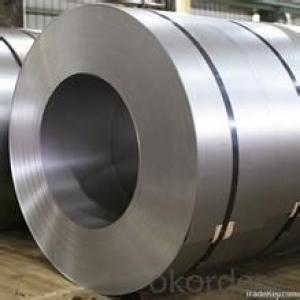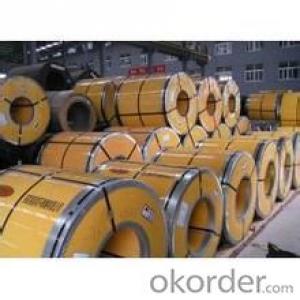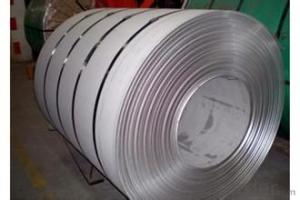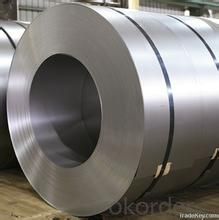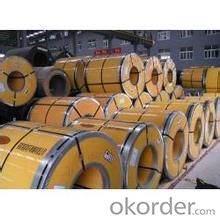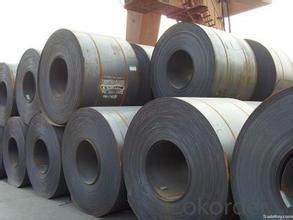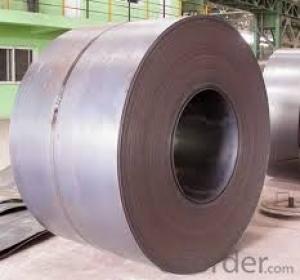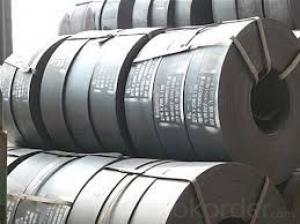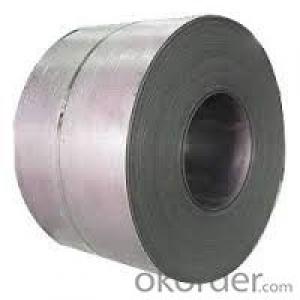Hot Rolled Steel Sheet in Coil DIN 17100 in Good Quality
- Loading Port:
- Tianjin
- Payment Terms:
- TT OR LC
- Min Order Qty:
- 20 m.t.
- Supply Capability:
- 500000 m.t./month
OKorder Service Pledge
OKorder Financial Service
You Might Also Like
Product Description:
Product: | Hot Rolled Steel Coils/Sheets |
Material: | Q195,Q235,A36,SS400,S235JR,Q345,ST37-2, CCSB etc |
Standard : | JIS G3002 GB/T251B |
Technique: | hot rolled |
Thickness | 1.2mm to 200mm |
Tolerance of thickness: | :+/-0.03mm |
Width: | 750mm-2000mm |
Tolerance of width: | :+/-5.00mm (aiming to +/-2.00mm) |
Normal width: | 914mm, 1000mm, 1200mm, 1219mm, 1250mm,1500mm |
Length: | According to requirement |
Coil ID: | 508mm-610mm |
Coil Weight: | 10-25 Metric Tons |
Surface: | Black, Chromate, fingerprint resistant treatment, slight oiled or non-oiled, dry |
Port of Loading: | Tianjin/Shanghai port |
Packaging Details: | Standard export packing or according to the clients required |
Delivery Time | Within 30 days after received 30% deposit or workable L/C |
Payment Terms: | L/C,T/T |
We can ensure that stable quality standards are maintained, strictly meeting both market requirements and customers’ expectations. Our products enjoy an excellent reputation and have been exported to Europe, South-America, the Middle-East, Southeast-Asia, Africa and Russia etc.. We sincerely hope to establish good and long-term business relationship with your esteemed company.
- Q: How are steel coils protected against moisture and humidity?
- There are several methods for protecting steel coils from moisture and humidity. One way is by applying a protective coating to the steel surface, which acts as a barrier against moisture. Coatings can be made of different materials, such as paint, zinc, or other substances that resist corrosion. In addition to coatings, steel coils are often wrapped in moisture-resistant materials like plastic or waxed paper. This wrapping provides an extra layer of protection during storage or transportation, preventing moisture from seeping into the coils. Furthermore, steel coils are typically stored in a controlled environment with regulated humidity levels. This helps to minimize the possibility of moisture condensation on the coil's surface. Storage facilities may also use dehumidifiers or other measures to control moisture and maintain optimal conditions. Lastly, proper handling and transport practices are essential for protecting steel coils from moisture and humidity. Special precautions are taken to avoid exposing the coils to rain or excessive humidity during loading, unloading, and transport. By implementing these protective measures, steel coils can be effectively safeguarded against moisture and humidity, reducing the risk of corrosion and preserving their quality and integrity.
- Q: What is the minimum temperature that steel coils can withstand?
- The minimum temperature that steel coils can typically withstand without undergoing significant changes in their physical properties is around -40 degrees Celsius (-40 degrees Fahrenheit). However, this can vary depending on the specific type and grade of steel used in the coils.
- Q: What processes and materials are used in the production of chrome steel
- well, save up some more $$. I wouldnt feel safe on a $120 mountain bike. My advice would be to invest in something that's a little more money. Also, why do you want a steel frame? Aluminum frames today are made from 7005 alloy, and stack up very well compared to the durability of steel. Plus, they wiegh alot less. Nowadays, youll only find steel on a cheap walmart bike, ir a top notch downhill bike made for extream offf road conditions.
- Q: How are steel coils inspected for edge quality?
- Inspectors use a combination of visual inspection and non-destructive testing methods to assess the edge quality of steel coils. During visual inspection, trained inspectors carefully examine the entire length of the coils to detect visible defects like cracks, chips, or uneven edges. Non-destructive testing methods, including ultrasonic testing and magnetic particle inspection, are also utilized to uncover any hidden defects or imperfections in the edges of the steel coils. Ultrasonic testing employs high-frequency sound waves to identify internal flaws or discontinuities in the steel, while magnetic particle inspection utilizes magnetic fields and particles to detect surface or near-surface defects. Both visual inspection and non-destructive testing methods are vital in guaranteeing the quality of the steel coil edges. Manufacturers can identify and resolve any defects or imperfections by conducting these inspections, thereby ensuring that the coils meet the required quality standards.
- Q: What are the different methods of coil joining for steel coils?
- There exists a variety of techniques for joining steel coils, each with its own advantages and limitations. Some commonly employed methods encompass the following: 1. Welding: Among the most popular methods of coil joining, welding involves the use of heat to melt and fuse the edges of steel coils. Arc welding, resistance welding, or laser welding can be utilized for this purpose. Welding offers a robust and durable joint, although it can be time-consuming and necessitate skilled operators. 2. Mechanical fastening: This technique entails the use of mechanical fasteners like clips, staples, or bolts to connect the edges of steel coils. Mechanical fastening is relatively quick and straightforward, and it allows for easy disassembly if needed. However, the joint may not be as strong as welding and can be prone to loosening over time. 3. Adhesive bonding: Adhesive bonding involves the use of a suitable adhesive or glue to bond the edges of steel coils. This approach yields a strong and uniform joint, while also providing protection against corrosion. However, adhesive bonding may require surface preparation and curing time, and it might not be suitable for high-temperature applications. 4. Interlocking or tongue-and-groove joints: This method involves shaping the edges of steel coils in a manner that they interlock or fit together like puzzle pieces. Interlocking joints provide good alignment and are easily assembled and disassembled. Nevertheless, they may not yield as strong a joint as welding or mechanical fastening. 5. Coil-overlapping: In this method, the edges of steel coils are overlapped and clamped together using mechanical means. Coil-overlapping is a simple and cost-effective technique, albeit it may not yield a strong joint and can result in uneven coil edges. When selecting the appropriate method of coil joining for steel coils, it is crucial to consider factors such as application requirements, strength requirements, cost, and production efficiency.
- Q: How are steel coils measured for thickness?
- Steel coils are measured for thickness using a variety of methods. One common method is using a micrometer, which is a precision measuring instrument that accurately determines the thickness of the coil. The micrometer is gently pressed against the surface of the coil and the measurement is taken. Another method involves using a thickness gauge, which is a handheld device that can quickly and accurately measure the thickness of the steel coil. The gauge is placed on the coil's surface and the thickness is displayed on a digital screen. In some cases, ultrasonic thickness testing is used to measure the thickness of steel coils. This method involves using ultrasonic waves that are emitted from a handheld device. The waves travel through the coil and bounce back to the device, providing an accurate measurement of the thickness. Regardless of the method used, it is important to ensure that the measurements are taken at multiple points across the coil to account for any variations in thickness. This ensures that accurate and reliable measurements are obtained.
- Q: What's the best way to clean granite countertops and stainless steel appliances? My countertops especially always look dull and streaky. Thanks!!!!!!!
- Stainless steel kitchen appliances look best when they're clean and shiny. To clean tough stains and cooking grease, and give them a dazzling shine, try the same detergent you would use when washing the dishes. One formulated to cut grease works especially well.This also works well for general kitchen cleaning.Waterless hand soap also works great as a polish, simply rub on, and polish - no rinsing. :) Don't use an ordinary kitchen cleaning product to clean granite. The newest technology uses peroxide and detergents to penetrate soiled areas. Simply spray a product such as Bio-OX Citrus Concentrate on the soiled area, allow it to penetrate for a few minutes, then wipe clean. Baking soda can be sprinkled on for a more abrasive cleaning action. Repeat if necessary. Granite can also be cleaned using warm, sudsy water (a mild detergent such as a grease cutting dish detergent or laundry detergent is fine) or a solution of borax and water. Thoroughly rinse and buff dry. To remove stains from granite, make a paste of baking soda and hydrogen peroxide or baking soda and Bio-OX Citrus Concentrate and cover the stain with the paste. Cover the paste with a damp cloth, leave overnight, then wet down and scrub with a nonmetallic scrubbing pad. Rinse thoroughly with clean water. Wipe up any spills as they happen so they don't soak in, and always dry coutertops after washing the dishes.
- Q: I want to purchase a set of knives made of carbon steel and want to be able to store them on a magnetic knife strip for handy access, I just wasn't sure if this alloy would stick to a magnet????Thanks
- Yes, carbon steels are magnetic. In fact, some stainless steel knives are magnetic as well. Some stainless steel alloys are naturally magnetic and some become magnetic when they are deformed by forging or rolling (check out a deep drawn SS sink and explore where it is magnetic and where it isn't). Depending on the details, some carbon steels can be made harder than the stainless steel typically used for knives (440 alloy) but the carbon steel knives are very much more likely to suffer corrosion. hope this helps
- Q: How are steel coils protected against UV radiation?
- Coil coating is a process that safeguards steel coils from UV radiation. This process entails applying a layer of paint or coating to the surface of the steel coil. By doing so, the coating acts as a protective barrier, shielding the metal from the harmful effects of the sun's ultraviolet rays. The protective coating used for steel coils is specifically designed to resist UV radiation. It contains pigments and additives that either absorb or reflect UV light, thereby reducing the amount of radiation that reaches the steel surface. To ensure maximum protection, the coating is applied in multiple layers. The first layer, called the primer, enhances adhesion to the steel surface and provides additional resistance against corrosion. Subsequent layers, such as the base coat and topcoat, improve durability and UV resistance. In addition to the coating, extra precautions can be taken to protect steel coils from UV radiation. This includes storing them in shaded areas or using covers to shield them from direct sunlight when stored outdoors. These measures minimize the exposure of the coated steel coils to UV radiation, helping to prolong their lifespan and maintain their appearance. Overall, the combination of a high-quality protective coating, proper storage, and handling practices ensures that steel coils are effectively shielded from the damaging effects of UV radiation. This allows them to maintain their structural integrity and aesthetic appeal for a long period of time.
- Q: How are steel coils used in the production of fireproof doors?
- Steel coils are used in the production of fireproof doors as they provide the necessary strength and durability to withstand high temperatures and prevent the spread of fire. The coils are formed into sheets or plates, which are then used to construct the framework and core of the fireproof doors. This ensures that the doors can effectively resist fire and protect buildings and occupants from its dangers.
Send your message to us
Hot Rolled Steel Sheet in Coil DIN 17100 in Good Quality
- Loading Port:
- Tianjin
- Payment Terms:
- TT OR LC
- Min Order Qty:
- 20 m.t.
- Supply Capability:
- 500000 m.t./month
OKorder Service Pledge
OKorder Financial Service
Similar products
Hot products
Hot Searches
Related keywords
